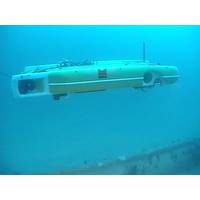
JDR Secures Cabling Work at Coastal Virginia Offshore Wind Project
offshore wind farm in the United States, capable of powering approximately 660,000 homes.To remind, Dominion Energy has already installed 78 monopile and four offshore substation foundations for as part of the first offshore construction campaign for the 2.6 GW project.DEME Group's heavy lift vessel Orion has been tasked with the installation of the monopile foundations, with the first offshore installation campaign concluded in November 2024.First Installation Campaign at Coastal Virginia Offshore Wind Farm Wraps Up"The CVOW project represents a major step forward in the US's renewable energy

Missing Titanic Submersible Update: Searchers Detect Subsea Sounds
Suleman, who are both British citizens.French explorer Paul-Henri Nargeolet, 77, and Stockton Rush, founder and CEO of OceanGate Expeditions, were also reported to be on board. Authorities have not confirmed the identity of any passenger.ROBOTIC SEARCH REDIRECTEDThe search effort included Lockheed P-3 Orion turboprop airplanes designed with sub-surface surveillance gear to detect submarines, Frederick said.The Canadian military dropped sonar buoys to listen for any sounds that might come from the Titan, and a commercial pipeline-laying vessel with a remote-controlled deepwater submersible was also searching

LOTOS Petrobaltic Selects Saab Seaeye Leopard ROV for Subsea Work in Polish Oil Fields
pipetracker.Their current Leopard configuration includes a Sonardyne DVL/INS survey system, Sprint-Nav INS, Digital Edge recording and event system, five cameras including Kongsberg HD system, also a One Laser for video and measurement, Tritech Super Seaking sonar, a seven-function manipulator, Schilling Orion gripper, electric torque tool, rotary disc cutter, WeSubsea dredge system, FlexiClean cleaning tool, water jet system and caviblaster, Cygus ultrasonic thickness gauge, multiplex survey pod and tooling sled.The Leopard package also includes a tophat tether management system (TMS), an ‘A&rsquo

Maritime Safety: POB Tracking Will Become Essential Offshore, Says Olympic Subsea
on board, but also as they transfer from the vessel to wind turbines and even within the turbine itself. Its other three vessels will get the system once the market improves and they return to service, Sørdal said.That first customer was BP Trinidad and the first vessel to be fitted was Olympic Orion, a 93.8m multipurpose offshore vessel built in 2012. And the tracking system Olympic Subsea installed was ConnectPOB, developed by Norway's ScanReach.ScanReach spent five years developing technology that can establish a wireless mesh of nodes throughout a vessel that avoids installing cables

Hybrid AUV Completes Depth of Burial Survey for Offshore Wind Farm
water depths ranging between 12m and 28m. The WTG’s are connected by 161 inter array cables which total circa 147km in length. The worksite is known for high subsea currents, so any solution had to cope with current up to 2kts.Modus mobilized its HAUV-2 system, equipped with Optimal Ranging Orion Cable Tracking System and dual head R2Sonic 2024 Multibeam Echosounder, on the chartered DP2 vessel “Noordhoek Pathfinder”. The inherent power and stability of HAUV-2 provides unrivalled high current workability and the system operated throughout the local tidal cycle. Despite

OSIL Buoy for Coastal Erosion Project
Ocean Scientific International Ltd (OSIL) have supplied a 1.2m data buoy platform to the “ORION” joint research and development center for use as a real-time monitoring station on an EU-funded project managing coastal erosion.The Harmonized Coastal Corrosion Management Framework for Enhancing the Implementation of the Integrated Coastal Zone Management Protocol (HERMES) project required a platform with the ability to record a full profile of water column currents, tidal variations, wave parameters (significant wave height, wave period & propagation direction) & estimated suspended

Unmanned Vehicles May Soon Take Up Residency Subsea
recharging and communications, in an indoor tank before going offshore to an Innogy-owned wind farm, Gwynt y Mor.In AUV mode, the Sabertooth has already done multibeam echosound pipeline tracking, magnetometer/gradiometer pipeline tracking and bottom sediment sampling. An electrical torque tool and an Orion a sensor for detecting buried pipeline or cable tracking have also been developed.Saab Seaeye also has plans for autonomous contactless cathodic protection measurements, using field gradient sensor technology. It’s also working on autonomous structure inspection and riser/umbilical/mooring

NASA, US Navy Practice Spacecraft Recovery at Sea
for recovering astronauts that have splashed down in the ocean upon returning from space travel. NASA’s deep space exploration systems will send a crew through space at 25,000 miles per hour, travelling some 40,000 miles beyond the Moon before coming back home. When returning to Earth, the Orion spacecraft will slow to a mere 300 mph as it passes through the Earth’s atmosphere, eventually slowing to 20 mph before it safely splashing down in the Pacific. The astronauts will need to be picked up as quickly as possible, and that’s where Kennedy Space Center’s NASA

NOAA Names Werner Director of Scientific Programs
Ocean Ecosystem Dynamics Program’s (GLOBEC) Scientific Steering Committee: 2003-2007; Chair of the Gordon Research Conference on Coastal Circulation Modeling, 2007; member of the International Geosphere-Biosphere Program (IGBP) Scientific Steering Committee from 2003-2007; member of NSF’s ORION iOSC 2007 & Science and Technology Advisory Committee (STAC) 2005-2007; member of the U.S. GLOBEC Scientific Steering Committee from 2000-2007; co-Chair of the PICES MODEL Task Team, 2001-2007; and member of the International Council for the Exploration of the Seas (ICES) Cod and Climate Change

 December 2025
December 2025





